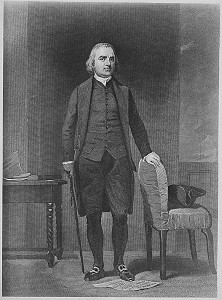Paine versus Burke
It is popular to describe the differences between two big divisions of each major political party.
For example, Democrats are sometimes called cluster liberals (who “view politics as a battle between implacable opponents”) versus network liberals (who “believe progress is achieved by leaders savvy enough to build coalitions,” even with the other party).
The two main types of Republicans are usually portrayed as fiscal versus social conservatives.
The divide may actually be more simple, according to a recent article by Yuval Levin (“Burke, Paine and the Great Law of Change” in The Point Magazine).
The roots of the two great American types of liberalism, says Levin, are found in the debates between Edmund Burke and Thomas Paine.
In truth, Americans aren’t really conservatives at all: “Conservative” means to remain the same, and since the American founding (indeed since the Pilgrims and others left the old countries) nearly all Americans have rejected the conservative royal model of Europe’s past. Nearly all Americans believe in progress and in changing government to meet new challenges.
In contrast to the European definition of “conservative,” American conservatism has come to mean holding on to old values, lessons and institutions — which is the Burke side of the 1790s debate. Burke said society was best served by an incremental approach to building on the best lessons of the past.
Paine believed, on the other hand, that every generation should reevaluate the current government and society and use reason to change whatever it thinks might improve things.
Paine view was that we
“…should not be bound by the past, but should choose anew society’s design…Burke thought Paine put too much stock in reason. Do not wise men disagree?”
Burke put his faith in the wisdom and institutions of the past, and warned that ignoring past lessons would cause many problems. He felt that too much faith in man’s reason alone would lead to party conflicts, waste and many failed government projects.
Paine was more concerned that dogmatic attachment to outdated traditions would keep society from progressing.
Modern Americans — liberal and conservative — nearly all want to make changes and see things improve. The interesting thing is that most network liberals and fiscal conservatives are followers of Burke while the majority of cluster liberals support Paine’s view.
This is further confused because many social conservatives are a mixed bag — they adopt Burke on issues like abortion and family values and Paine on issues from immigration to Iraq and Afghanistan.
Sides Versus Fusion
Confused yet? Many people are. But this is more than just an indication of how much the American political landscape has changed since 1989. Independents, the true majority now, are fans of both Burke and Paine.
They believe in keeping the best of the past and also in making commonsense changes when needed.
As long as independents are the majority (and it appears this will be for a long time), the future of conservatism is liberal (meaning a constant push for change in Washington) and the future of liberalism is controlled by independents.
The far left and right can shout as loudly as they want, but the future of America belongs to those who believe in the best of the past (like the U.S. Constitution) and making changes to improve society in each generation. Like it or hate it, this is the reality now.
In a sense, though, this is a return to the American way. George Washington embodied both views: Burke and Paine, attachment to the old lessons and changes to improve things.
After Washington, electors traded back and forth between presidents who emphasized Burke’s views and those who preferred Paine’s ideals. The modern two-party system consistently pits these two worldviews against each other.
Third Party Versus No Party
It remains to be seen what a return to the combination of both views by a majority of the populace — the independents — will bring. Many wonder if a third party is ahead.
But, perhaps, the rise of independents will resurrect support for another model popular in the founding era: A non-party federal government where independent voters elect the best people to office without the circus of political parties.
For those who say this can’t happen, remember how small and impotent independents were just three decades ago. The one constant in political history is change, and the one thing we can count on for sure is that many things will occur which the experts have deemed impossible.
Santayana said that unless we learn from the mistakes of history we are doomed to repeat them, and both Paine and Burke knew that difficult things are possible. America was built on the belief that hard advances are, in fact, likely.
On a technical level, a true third party could create the same thing as a no-party model — at least in presidential politics.
Since the president must be elected by a majority (e.g. 51 percent), not just a plurality (say the highest vote, but only 42 percent) of the electoral college, having three truly popular party candidates (all with their own electoral college representatives) would usually put elections in the hands of independent voters.
At some point, independents may decide that being forced to choose between the two big parties just isn’t getting the job done.
In the meantime, independent support is there for the taking by any president who is willing to re-emphasize the Constitution, fiscal responsibility, social justice and other best lessons of the past along with exerting the leadership to do big things that require change and deeply matter.
America is greatly in need of a truly shared and great purpose, and citizens of all major viewpoints will naturally rally to such leadership when/if it comes.
***********************************
 Oliver DeMille is the founder and former president of George Wythe University, a co-founder of the Center for Social Leadership, and a co-creator of TJEd Online.
Oliver DeMille is the founder and former president of George Wythe University, a co-founder of the Center for Social Leadership, and a co-creator of TJEd Online.
He is the author of A Thomas Jefferson Education: Teaching a Generation of Leaders for the 21st Century, and The Coming Aristocracy: Education & the Future of Freedom.
Oliver is dedicated to promoting freedom through leadership education. He and his wife Rachel are raising their eight children in Cedar City, Utah.







[…] This post was mentioned on Twitter by Geneva Murphy, Social Leadership. Social Leadership said: Is a no-party system possible? http://bit.ly/haZOVK #politics […]